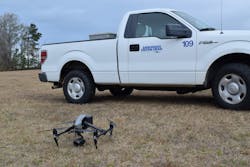Woolpert is driving the evolution of airport drone usage as the company recently conducted nighttime unmanned aircraft system (UAS) operations at McGhee Tyson Airport (TYS).
The allowance of nighttime operations on the airfield lets the company test the capabilities of UAS technology in protecting airfield perimeter security by monitoring for wildlife or intruders on the field.
“It’s giving another perspective for airport operations,” said Aaron Lawrence, technology team manager for UAS Operations at Woolpert. “It’s providing another tool in the toolbox.”
Using UAS in airport operations is a big topic across the North American aviation leaders in recent years as drone technology continues to mature. Companies and different industry thought leaders have discussed a flurry of different types of applications. Lawrence said their focus is getting this technology into the hands of airport operations staff to take on daily task to address different challenges like wildlife mitigation. If successful, the same technology would help other areas like security.
Savannah/Hilton Head International Airport (SAV) has a significant portion of its northern fence located within a swamp. Lawrence said UAS technology allows operations staff to inspect the fence line without having to send staff into a potentially treacherous area.
“It’s complimentary, Lawrence said. “It’s not taking anyone away from the operations team but assisting them.”
Woolpert recently earned FAA Class C airspace authorization to operate UAS anywhere on an airfield at SAV. Lawrence said they went through the FAA Safety Risk Management panel utilizing the company’s data surrounding UAS usage to build a plan that now creates precedence for other airports seeking the same authorization.
Is UAS the Answer for Your Airport?
If you’re thinking about drones for your airport, Lawrence said it’s important to think about the usage. For example, if airport operations teams can drive the entire fence line of your airport to conduct inspections, a UAS solution might not be necessary. Battery life on current UAS technology also won’t allow one unit to scan a larger perimeter on just one pass.
And it takes more than buying an aircraft an training a pilot. You need infrastructure. Consider where you’d store 4K video of a fence line covering 20 square miles.
You also need a data workflow plan. Build a plan so you know how long you’re keeping data collected with the system and how it will be organized so it becomes useful.
But most importantly, consider finding a consultant experienced in UAS implementation that’s proactive in keeping airport staff as part of the learning process.
“There’s no time where Woolpert is operating a UAS at Savannah where airport operations aren’t with us,” Lawrence said. “The goal is to hand this off to them, so in another year or two, they will be doing their own inspections.”







